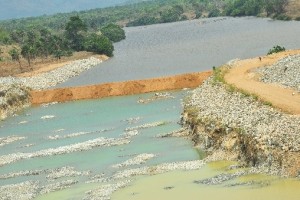Report from Federal Ministry of Water Resources.
The Kashimbila multipurpose dam which was started in 2010 in Kashimbila, Takum Local Government, Taraba State very close to the border of Republic of Cameroon has now reached final stage of completion as the officials of the Federal Ministry of Water Resources and SCC construction company, the contractor handling the project have launched “water diversion” to enable the contractors complete the last stage of the dam.
At the beginning of the construction of the dam, the upstream and downstream of River Katsina Ala were blocked to allow passage of water through other channels for the work to commence. Having completed all the major work, the water was now re-channeled from its original course where work had not been done to the dam site where construction was completed. This was to enable the contractors work on the side that has not being completed. The water is currently released out through channels provided in the dam and later it would be closed for impending water when the whole work is completed.
While briefing the official of the Ministry of Water Resources during the water diversion on Tuesday, 1st April, 2014, the project consultant, Engr. Musa Ayanwola said that water diversion was the critical aspect of dam construction.
He said, “It is critical because this exercise will enable us to work within the river channel and for us to do that it require us to create diversion area; without good diversion, all the work that we are going to do in river channel can be washed away.”
He added that they had worked on both flanks of the river and what remained was to work within the river channel and that was why he considered the exercise very important and critical.

Kashimbila dam after Water Diversion

Kashimbila dam before Water Diversion
“In dam construction, we have two major diversions, this one that we are about to do now is to enable us work within the river channel; by the grace of God at the end of the construction within the river channel, the dam will almost be ready for closure; that will be the second diversion we are talking about”, he explained.
In his remarks during the event, the representative of the Minister of Water Resources, Engr. Joe Kwanashie who is the Director, Irrigation and Drainage Department explained that the dam was designed to contain 500 million cubic meters of water; it is expected to curtail poisonous gas and flooding that may likely erupt from Lake Nyos in Republic of Cameroon, in case it breaks down. He added that the dam had hydropower component of about 40 megawatts. “It would also provide water supply to Takum Local Government and its environs and it has potentials to irrigate about 2000 hectares of land.”
“The dam will provide water for irrigation of about 2000 hectares of land, and with that kind of land under cultivation all year round, it will improve the economy of this area and will enhance food security, it will reduce dependency on food importation there by the improving the transformation agenda in agriculture”, he further explained.
He said that 40 megawatts of electricity would be generated this year and that would be added to the national grid to boost power supply in Nigeria.
The Director Dams and Reservoir Operation, Engr. Reginald Ikpeawujo commended the contractors for the good work and assured that the project would be completed by the end of 2014. He said that the work had reached about 85 percent completion. “All the turbines and other equipment for the hydro power are on ground, work is going on 24 hours, we are sure of completing it by the end of the year”, he said.
The Project manager, Engr. Michal Roebin who conducted the representative of the Minister and other officials of the Federal Ministry of Water Resources round the dam, said that since the commencement of the project in 2010 they have been working very seriously to ensure that the project is delivered at the expected time of completion.
Support InfoStride News' Credible Journalism: Only credible journalism can guarantee a fair, accountable and transparent society, including democracy and government. It involves a lot of efforts and money. We need your support. Click here to Donate
